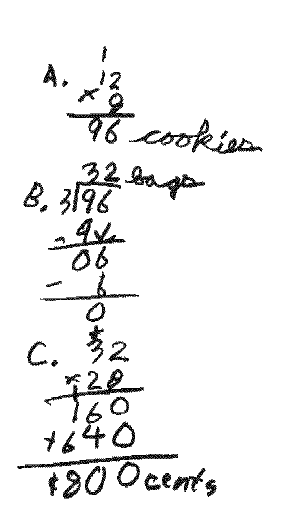
A “School Fundraiser” Math Prompt
by Tim Horrigan, former Measured Progress test scorer
(August 2005)
One of the most ubiquitous genres of Measured Progress test prompts is the “School Fundraiser” word problem. A group of kids wants to do something for a school fundraiser, i.e., they want to make an arbitrarily defined quantity of something of not very much value which they can then sell for a rather small amount of money. (This is kind of a sad commentary on the American school funding system.) The student's job while taking the test is to do some simple arithmetic to determine just how little money the school will receive.
This is a rather classic example from the Montana 4th grade test:
|
Toby and Jasmine are making cookies for a bake sale. They are going to put 12 cookies on each pan and bake 8 full pans of cookies. |
|
a. How many cookies will Toby and Jasmine bake? Show or explain how you know. |
|
b. Toby and Jasmine plan on putting 3 cookies in each bag to sell. How many bags will they need for all of their cookies? Show or explain how you know. They are going to sell the bags of cookies for 25¢ each. How much money will Toby and Jasmine make if they sell all of the bags of cookies? Show or explain how you know. |
The answers are (as usual ignoring extraneous concerns like the cost of cookie dough, etc.):
12 cookies/pan * 8 pans = 96 cookies
96 cookies ÷ 3 cookies/bag = 32 bags
32 bags * $0.25/bag = $8.00
Why 96 cookies rather than 100? Or even 200? Why 3 in a bag? Why not sell them separately for a dime each? Why not buy pre-made cookies at Sam's Club? Who the heck knows? Happily for the test developers, kids know enough not to ask questions like this. (The answer to my next to last question, actually, is that Toby & Jasmine can make the cookies for free.)
This is one of those questions where the scorer has to deal with test points as well as scoring points. Each one of the three subsections is worth 2 test points, one for the answer itself and one for “strategy” (e.g., knowing you're supposed to multiply the price of a bag by the number of bags to determine the gross sales revenue.) A perfect test point score (6) translates to a 4 score points.
Test scorers record the score using a proprietary program called i-Score. This program only allows the scorer to record exactly one scoring-point score per question. The software does NOT do the translation between the two parallel scoring systems, and of course it also does not record the test points for each subsection. This creates a lot of extra work for the test scorers, and gives them an additional opportunity to make an error. Not only does a scorer have to correctly characterize the answer and strategy for each section in the response, she has to keep a running tally in her head (or perhaps on scrap paper) as she goes. Even this very simple question has a non-trivial algorithm for translating test points to scoring points.
The rubric is as follows:
|
Score |
Description |
|
4 |
6 points |
|
3 |
5 points or 4 points with points from every part |
|
2 |
2 to 4 points with points from more than one part |
|
1 |
1 to 2 points or minimal understanding of solving multi-step problems |
|
0 |
Response is incorrect or contains some correct work that is irrelevant to the skill or concept being measured |
|
Blank |
No response |
The anchor examples are pretty straightforward. The only tricky consideration arises when you look at the first anchor 4 vis a vis the second anchor 3. The student who gets the 4 writes the answer to part c (after showing her work) as “$800cents”. This is not standard notation, but it is still clear enough for a 4 (in elementary school, at least.) The student who gets the 3 does the exact same multiplication (32 times 25) but shows it simply as “800” and gets dinged for this. It is often hard for the scorer to figure out which minor errors in notation are OK, and which aren't (and, also, sometimes it is also hard to tell what's a decimal point and what's simply a speck.)
The first anchor 4:

The second anchor 4:
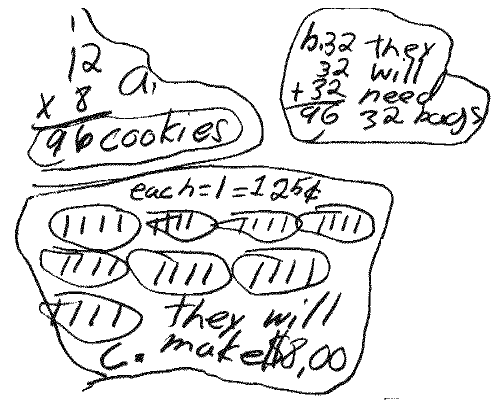
The first anchor 3 (right strategy but wrong answer in part c):
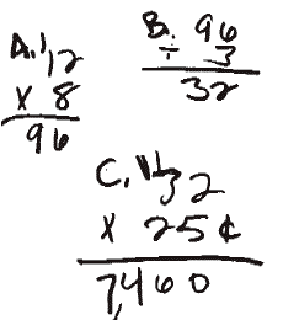
The second anchor 3 (wrong notation for part c, as discussed previously):
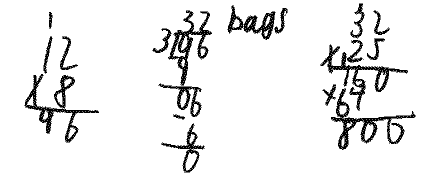
Now we come to the 1s and 2s. As you will see, sometimes the 1s are closer to the right answer than the 2s. The second anchor 2 for this question has three very, very wrong answers, while both 1s contain some correct information.
The first anchor 2 (4 test points: part a perfect, part b wrong, part c right based on part b; that is to say, this actually is the amount Toby & Jasmine would gross if they sold 288 bags rather than 32):

The second anchor 2 (much weaker than the first anchor 2: looks totally wrong, but correct strategy is shown for part a and part c):
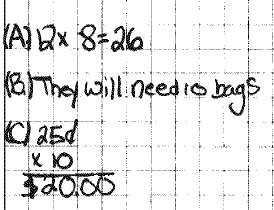
The first anchor 1 (with 2 test points as in the second anchor 2; but here they come only from part c, where the student correctly shows how much Toby & Jasmine would gross if they sold 60 bags of cookies):
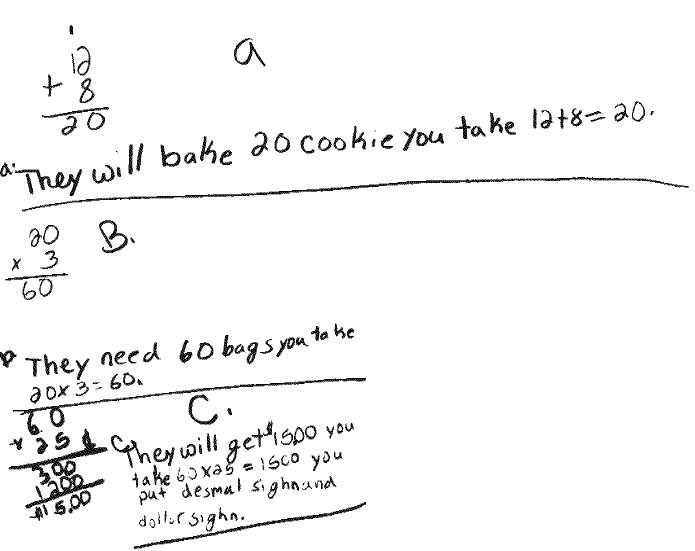
The second anchor 1 (correct answer with no calculation for part a, everything else worth zero):
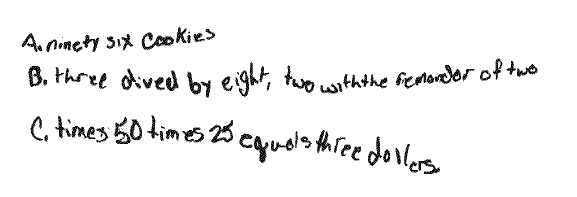
For more information visit: